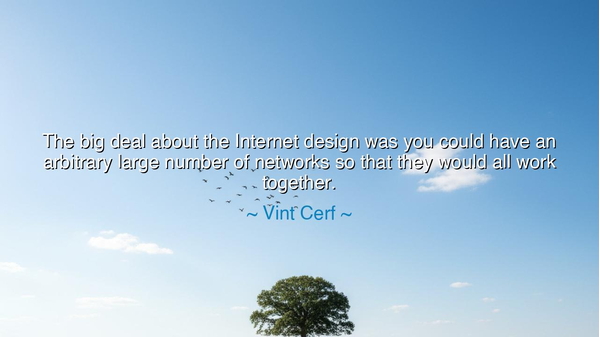
The big deal about the Internet design was you could have an
The big deal about the Internet design was you could have an arbitrary large number of networks so that they would all work together.






“The big deal about the Internet design was you could have an arbitrary large number of networks so that they would all work together.” Thus spoke Vint Cerf, one of the founding fathers of the digital age, a visionary whose mind shaped the invisible highways that now connect the hearts and thoughts of humankind. To the ordinary ear, his words may sound technical, even simple—but beneath them lies a revelation as profound as any invention of fire or wheel: that the true power of creation lies not in isolation, but in connection.
When Cerf and his peers gave birth to what we now call the Internet, they did not merely create machines that speak to each other; they wove together the threads of civilization itself. The idea that an “arbitrary large number of networks” could coexist and cooperate was revolutionary. It meant that no single empire, no single voice, could own the flow of knowledge. It was a vision of unity through diversity—a design that mirrored the universe itself, where countless stars shine in harmony, each unique, yet bound by gravity to a greater whole.
In the ancient days, humanity was divided by distance. A message had to cross oceans or mountains, carried by ships or beasts of burden. Ideas were imprisoned within kingdoms, and wisdom often perished with the men who held it. But with the dawn of the Internet, barriers fell. A whisper in one land could become a song across the world. Networks working together became the new cathedral of human progress, a living monument to collaboration. Cerf’s design was not just technological—it was philosophical. It declared that cooperation, not control, is the foundation of endurance.
Consider the tale of Alexander Graham Bell, the father of the telephone. When he first connected two voices across a wire, it was a miracle—a bridge between distances once thought unbridgeable. Yet even Bell’s invention was but a single path, a line from one point to another. What Cerf envisioned was infinite—a web where every voice could find another, where knowledge could travel freely, unchained by geography or power. It was the democratization of communication, a design that reflected the dream of every philosopher who ever sought unity among humankind.
And yet, the greatness of Cerf’s insight lies not only in the triumph of invention but in its moral echo. For what he built in wires and code, we must build in our lives. Each of us is a network—a collection of ideas, memories, and relationships. Alone, we flicker like solitary lamps; together, we become a constellation. The principle that guides the Internet—that many systems can work together without losing their individuality—is a lesson for the soul. True strength does not come from uniformity, but from connection among differences.
But let us also remember that what was created for unity can be twisted by division. The same networks that carry knowledge can carry falsehoods; the same design that brings people together can be used to tear them apart. Therefore, we must be guardians of the web, ensuring that our connections are guided by truth, empathy, and respect. The Internet is a reflection of humanity itself—if we fill it with light, it shall illuminate the world; if we fill it with darkness, it shall magnify the shadows.
The lesson is timeless: build systems—whether of technology, friendship, or society—that connect rather than divide. Seek harmony where others see competition. When you create, create with the intention to include. Let your own mind be like Cerf’s Internet—capable of holding an “arbitrary large number of networks”—of thoughts, people, and perspectives—and let them all work together in the grand architecture of wisdom.
For in the end, what Cerf taught us is not only how to build the Internet, but how to build civilization itself. A world that endures is one that communicates, cooperates, and grows without end. As the ancients once built roads for empires, he built pathways for ideas. Let us walk them with reverence. And as we move through this vast digital cosmos, let us remember: connection is not just a feature of design—it is the destiny of humanity.






AAdministratorAdministrator
Welcome, honored guests. Please leave a comment, we will respond soon